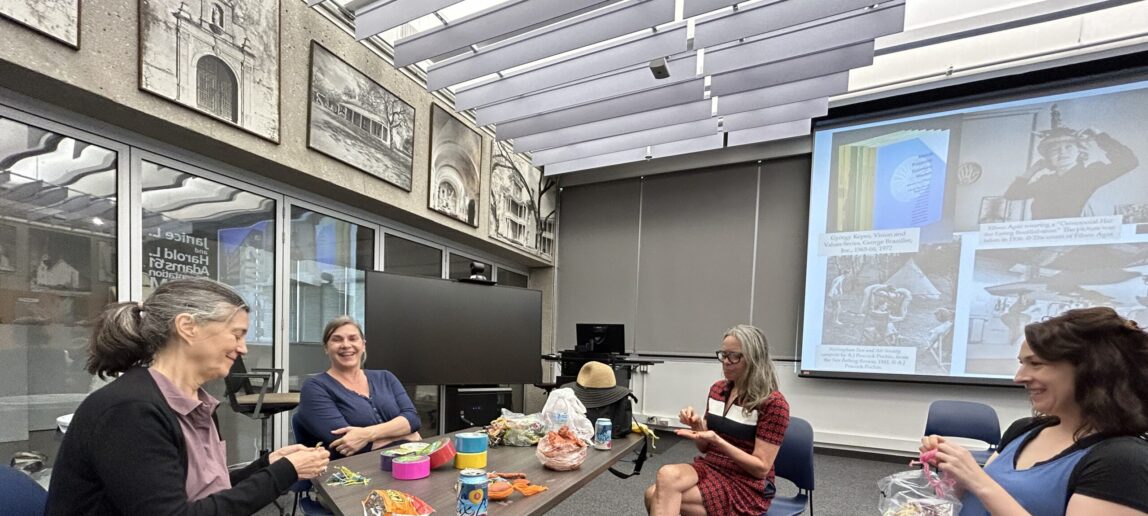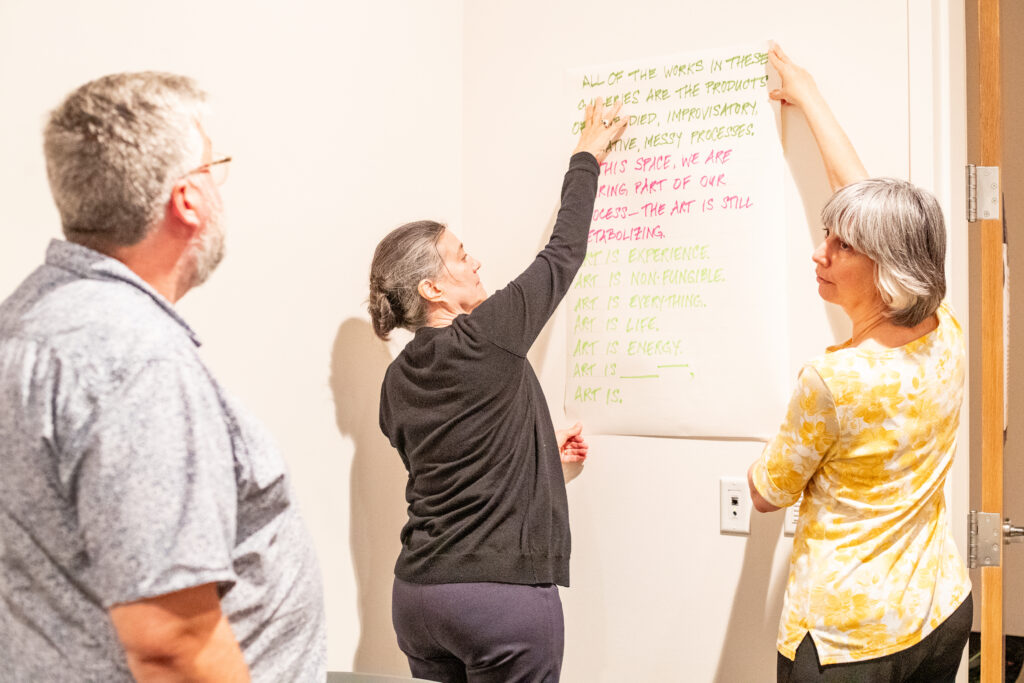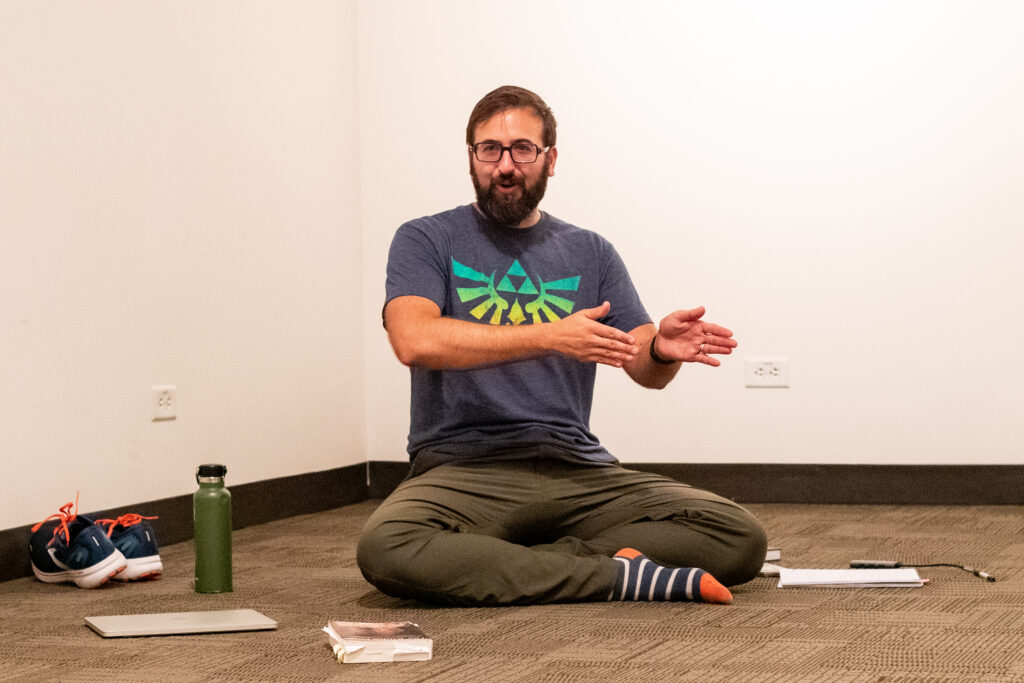‘Metabolism, A Happening’ Brings Artists, Students, Faculty Together To Examine Creative Process In Making Art

A recent collaborative art-making experience at the College of Performance, Visualization and Fine Arts explored the energy that drives the creative process.
“Metabolism, A Happening,” brought together faculty, students and community members in June for a weeklong workshop. The event included visiting artist Meredith Tromble from the University of California, Davis; Dr. Laura Hyunjhee Kim and Dr. Charissa Terranova, both from the University of Texas at Dallas. The objectives: share inspiration, collaborate and examine how art is created.
“Metabolism is this very primal, creative thing that our bodies do where they change one thing into another thing,” Tromble said. “It’s a reality, but it’s also a metaphor for the process that people experience when something happens and their world transforms. Something changes a little bit, and that’s all a movement of energy.”
Each day began with a morning discussion led by the guest artists. These sessions evolved into interactive lectures in which students created art on a long roll of paper based on what the artist was presenting.
“It was very different from a class where you’re trying to teach people a particular thing,” Tromble said. “This was more like we laid the structure for something to happen, and then it just caught fire. You’re not really controlling it. You’re just kind of moving with it.”

The result was a physical representation of the discussion complete with notes, drawings and three-dimensional attachments made of yarn and paper.
The lectures were followed by personal and group work. Dr. James R. Ball III, assistant dean for industry and community engagement, said many participants followed where the creative energy took them. Some students brought their Ph.D. projects and school assignments, occasionally shifting from their own work to collaborate with other participants.
Andersen Wood, a junior visualization major, recounted an activity in which participants were passing around yarn. They would make suggestions on what to do with it and then others would follow along. They spun it into a web, placed people within it and eventually wrapped it up into a sculpture.
“People were just bouncing ideas off each other,” Wood said. “It just kind of grew and expanded and changed into this fun, colorful explosion.”
Dr. Dawna Schuld, associate professor of modern and contemporary art history, emphasized the openness the workshop created. It was important that students experience a space in which it’s OK to make mistakes in working with others, she said, and to be able to see their professors do the same alongside them.
“You can’t produce anything worthwhile without messing up,” Schuld said. “It’s important to have a place where you can have conversations about what’s working and what’s not, and start to develop a vocabulary for that so that you can feel more confident in your own work. I’m hoping this helps in that regard, because this anxiety about producing the perfect work of art ironically will keep you from producing art at all.”
The group worked in mediums including sculpture, drawing and digital art. Ball said one of the digital projects took inspiration from the idea of “exquisite corpse,” a surrealist exercise in which a paper is folded in half. Two artists then draw on each half without knowing what the other is drawing to create a “monster.” For a digital version, participants took turns leaving the room to shoot video footage of something they found in the surrounding area. They then returned the camera to the next person, who did not know what had been shot.
Participants utilized the Black Box Theater of the Liberal Arts and Arts & Humanities Building to create video performance art. Video clips were cast onto participants as they recited monologues and swayed back and forth within the light. For some scenes, they wore paper costumes they had made.

On the morning of the final day, Joshua DiCaglio, assistant professor in the Department of English, discussed his book “Scale Theory: A Nondisciplinary Inquiry.” It began with a yoga session to demonstrate the mind’s connection to the systems within the body, and the body’s connection to systems in the world.
“In the English department, it’s surprising if you ask someone to stand up and move as part of an academic talk,” Ball said. “Not in the College of Performance, Visualization and Fine Arts. You’ve got to get up and move. We were all game.”
DiCaglio had participated throughout the week, stopping by to listen in on morning lectures, Ball said. Part of his discussion was woven into the yarn sculpture by Dr. Jinsil Hwaryoung Seo, associate professor in the visualization program. By pressing on the sculpture in a certain way, a recording of DiCaglio speaking would play. Press elsewhere and other sounds played — a birdsong, for example — related to the environment in which the sculpture was made.
The findings and processes of the artists were put on exhibition in the J. Wayne Stark Galleries after the week ended. It showcased the yarn sculpture, a long wall of creative note-taking and videos shot at the Black Box Theater and around campus, along with videos made in advance by Tromble and Kim that were shown for inspiration.
Schuld said the experience allowed her to see campus in a new light through the eyes of the visiting artists. She joined Tromble as she visited different schools and departments around campus that aligned with Tromble’s interest in art and science. It afforded Schuld the opportunity to make connections across campus that she may not have otherwise made.
Bringing these artists to campus also helps to spread the word about the College of Performance, Visualization and Fine Arts, Schuld said.
“We aim to be part of a national community,” Schuld said. “This isn’t an isolated thing. We think that we have something of value that we can share with others in this interdisciplinary art program.”